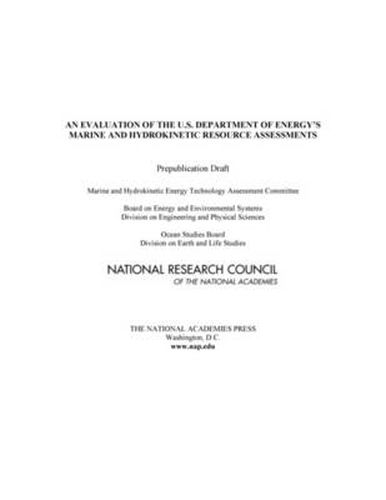Readings Newsletter
Become a Readings Member to make your shopping experience even easier.
Sign in or sign up for free!
You’re not far away from qualifying for FREE standard shipping within Australia
You’ve qualified for FREE standard shipping within Australia
The cart is loading…






Increasing renewable energy development, both within the United States and abroad, has rekindled interest in the potential for marine and hydrokinetic (MHK) resources to contribute to electricity generation. These resources derive from ocean tides, waves, and currents; temperature gradients in the ocean; and free-flowing rivers and streams. One measure of the interest in the possible use of these resources for electricity generation is the increasing number of permits that have been filed with the Federal Energy Regulatory Commission (FERC). As of December 2012, FERC had issued 4 licenses and 84 preliminary permits, up from virtually zero a decade ago. However, most of these permits are for developments along the Mississippi River, and the actual benefit realized from all MHK resources is extremely small. The first U.S. commercial gridconnected project, a tidal project in Maine with a capacity of less than 1 megawatt (MW), is currently delivering a fraction of that power to the grid and is due to be fully installed in 2013.
As part of its assessment of MHK resources, DOE asked the National Research Council (NRC) to provide detailed evaluations. In response, the NRC formed the Committee on Marine Hydrokinetic Energy Technology Assessment. As directed in its statement of task (SOT), the committee first developed an interim report, released in June 2011, which focused on the wave and tidal resource assessments (Appendix B). The current report contains the committee’s evaluation of all five of the DOE resource categories as well as the committee’s comments on the overall MHK resource assessment process. This summary focuses on the committee’s overarching findings and conclusions regarding a conceptual framework for developing the resource assessments, the aggregation of results into a single number, and the consistency across and coordination between the individual resource assessments. Critiques of the individual resource assessment, further discussion of the practical MHK resource base, and overarching conclusions and recommendations are explained in An Evaluation of the U.S. Department of Energy’s Marine and Hydrokinetic Resource Assessment.
$9.00 standard shipping within Australia
FREE standard shipping within Australia for orders over $100.00
Express & International shipping calculated at checkout
Increasing renewable energy development, both within the United States and abroad, has rekindled interest in the potential for marine and hydrokinetic (MHK) resources to contribute to electricity generation. These resources derive from ocean tides, waves, and currents; temperature gradients in the ocean; and free-flowing rivers and streams. One measure of the interest in the possible use of these resources for electricity generation is the increasing number of permits that have been filed with the Federal Energy Regulatory Commission (FERC). As of December 2012, FERC had issued 4 licenses and 84 preliminary permits, up from virtually zero a decade ago. However, most of these permits are for developments along the Mississippi River, and the actual benefit realized from all MHK resources is extremely small. The first U.S. commercial gridconnected project, a tidal project in Maine with a capacity of less than 1 megawatt (MW), is currently delivering a fraction of that power to the grid and is due to be fully installed in 2013.
As part of its assessment of MHK resources, DOE asked the National Research Council (NRC) to provide detailed evaluations. In response, the NRC formed the Committee on Marine Hydrokinetic Energy Technology Assessment. As directed in its statement of task (SOT), the committee first developed an interim report, released in June 2011, which focused on the wave and tidal resource assessments (Appendix B). The current report contains the committee’s evaluation of all five of the DOE resource categories as well as the committee’s comments on the overall MHK resource assessment process. This summary focuses on the committee’s overarching findings and conclusions regarding a conceptual framework for developing the resource assessments, the aggregation of results into a single number, and the consistency across and coordination between the individual resource assessments. Critiques of the individual resource assessment, further discussion of the practical MHK resource base, and overarching conclusions and recommendations are explained in An Evaluation of the U.S. Department of Energy’s Marine and Hydrokinetic Resource Assessment.